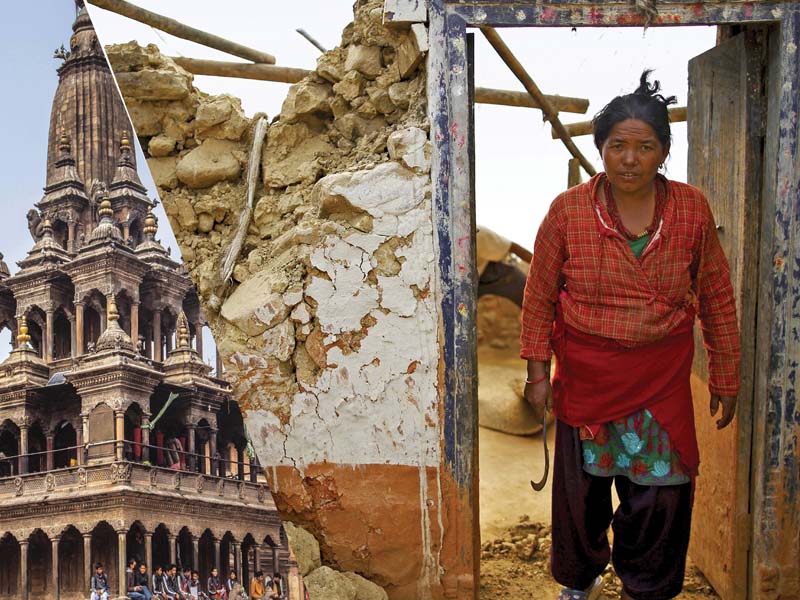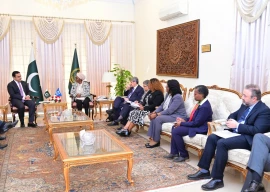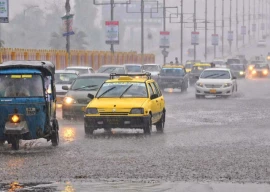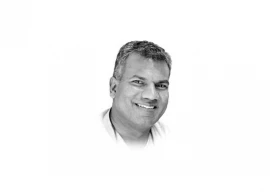
Two years ago, Nepal was at the peak of development. The government had pumped money into building wider roads in Kathmandu, the capital city, and the country was heading towards prosperity and progress. Although poverty was endemic, people were filled with a renewed sense of hope for the future. Elections were to be held in a month’s time and there was palpable sense of change in the air. Nobody could have imagined that two years down the line a single natural calamity would shatter the promise of a new Nepal.

A local resident stands in front of the ruins of his home after the April 25 earthquake, in Bhaktapur Nepal. PHOTO:REUTERS
I was in the country to attend a week-long teachers workshop in Kathmandu. My Pakistani colleagues and I, along with other attendees, were stationed at the Park Village Resort in Thamel. Our mornings and afternoons were taken up by the workshop and daily assignments, but in the evenings we were free to step out to explore the city.
Kathmandu does not have much of a night life. The city is not very active after 8:30 pm; most of the shops close down before 9:00 pm, except in the tourist district of Thamel, which houses numerous restaurants, hotels and shops that remain open till late. Here you will find vibrant pashmina shawls and their cheaper local substitute, yak wool shawls. If you venture out late at night, however, be warned that you’ll have no option but to take an expensive taxi ride back to your hotel.

Durbar Square has been one of the most famous spots for tourists in Kathmandu. PHOTO CREDIT: ABDUL AZIZ KAZI
Since most of us were visiting Nepal for the first time, we wanted to familiarise ourselves with its historical sites and culture. One of the famous tourist attractions we visited was the Hanuman Dhoka Palace Museum in Kathmandu, a residential and administrative centre of Nepali Kings from ancient times. The Palace was originally founded during the Licchavi period, with several structural additions, including a statue of Hanuman to protect the Palace against enemies in 1672, made by King Pratap Malla in the 17th Century. Although monarchy was formally abolished in Nepal in 2008, the structure housing thrones used during their crown prince’s accession and coronation have been carefully preserved. Since tourists are strictly forbidden from taking pictures inside the museum, we were forced to safely secure our cameras inside free lockers provided to tourists.
History and religion are placed on the same pedestal in Nepal. Along with historical sites, Kathmandu is replete with temples and stupas. There was even a statue of sitting Buddha in one of the resort’s many gardens. To witness the rituals and get a deeper sense of the religiosity among people, we decided to visit a temple of Lord Shiva located at a 15-minute walking distance from the resort. A receptionist at the hotel had informed us that if we wanted to observe the rituals, we must visit the temple early morning.
To our surprise, there was a large group of people, young and old, present at the temple at around 7:00 am. At the centre of the structure was a heavily-fenced pond containing a large statue of Lord Shiva in a sleeping posture. Devotees, including schoolchildren in their uniforms, gathered around the pond laying flowers and praying for good health and prosperity. Taking pictures of Lord Shiva and the temple, however, was strictly forbidden.

Katmandu’s Durbar Square, a Unesco world heritage site. PHOTO CREDIT: ABDUL AZIZ KAZI
The earthquake has flattened many of the structures mentioned above, but it won’t be able to wipe out fond memories of this peaceful city and the moments we shared with its hospitable populace. While taking a casual stroll through a lane close to the resort on our final evening in the city, we stumbled upon a grand first birthday celebration taking place nearby. Upon realising that we were tourists, the family instantly invited us to attend the function and be a part of the merriment by witnessing the customs. The family not only lavished us with attention, but also invited us for dinner despite our strongest refusal. With Nepali music in the background and the aroma of spicy lentils and rice wafting through the air, we concluded our trip in the city on a high note. Nothing will make me happier right now than knowing that the family and the little one are safe somewhere in the city.
Relief efforts

Local residents walk past collapsed houses, at Lamosangu village in Sindhupalchowk. PHOTO:REUTERS
Multiple teams of rescuers from more than 20 countries have been using sniffer dogs and heat-seeking equipment to find survivors in the rubble of Nepal’s worst earthquake in more than 80 years. Relief efforts continue undeterred after the latest earthquake on May 12.
Pakistan has been dispatching C-130 aircraft carrying 30-bed hospitals, specialised search and rescue teams and relief goods to Nepal since the last week of April. Army doctors — including specialists such as gynecologists and radiologists — are part of the Pakistani rescue teams. Prime Minister Nawaz Sharif has approved provision of 20,000 tents, 20 tons of rice and medicines for earthquake relief on the request of the Nepalese authorities.
Pakistan has sent food items including 2,000 ready-to-eat meal packs, eatables, water bottles, medicines, 200 tents, and 600 blankets.
India has sent 16 teams of the National Disaster Relief Force, in addition to medical assistance and relief provisions. Helicopters have also been provided to rescue those in remote areas.
Washington announced an initial sum of $1 million in aid, and pledged a disaster response team to assist in rescue efforts.
Australia has pledged $5 million through charitable organisations.
Japan, no stranger to earthquakes, sent an initial team of 70 to aid the rescue of those stranded in far off areas.
China sent an initial team of 62 rescue workers, including sniffer dogs.
Gulnaz Mondegarian has 28 years of teaching experience and likes to write during her spare time.
Published in The Express Tribune, Sunday Magazine, May 17th, 2015.























COMMENTS
Comments are moderated and generally will be posted if they are on-topic and not abusive.
For more information, please see our Comments FAQ